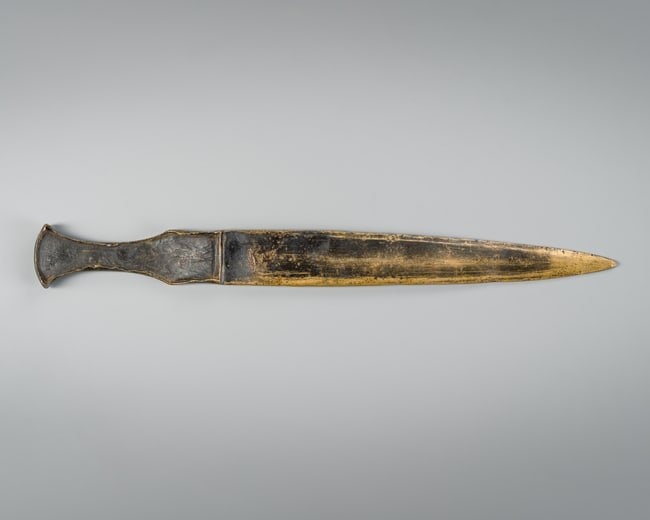A LURISTAN BRONZE SWORD, 11TH CENTURY BC
A LURISTAN BRONZE SWORD, 11TH CENTURY BC
Iran. Cast with a narrow, tapering blade, the hilt cast with a hollow section for an additional wood or stone fitting terminating in a flared pommel. The bronze has a dark patina rubbed smooth along the edges.
Provenance: From a Royal Collection in France. With an old inventory label, '324.'
Condition: Very good condition, commensurate with age. Wear, casting flaws, expected losses, small nicks and dents. The bronze with a fine, naturally grown, dark patina.
Weight: 262 g
Dimensions: Length 36.8 cm
Luristan bronzes are small, decorated objects from the Early Iron Age (first millennium BC) which have been found in large numbers in Lorestan province and Kermanshah in western Iran. They include a great number of ornaments, tools, weapons, horse fittings, and a smaller number of vessels including situlae and are characterized by a wide range of idiosyncratic forms and a highly stylized conception of human and animal representation. Those from recorded excavations were generally found in burials. The ethnicity of the people who created them remains unclear, though they may well have been Indo-European, possibly related to the modern Lur people who have given their name to the area. Luristan bronze objects came to the notice of the world art market from the late 1920s onwards. They were excavated in considerable quantities by local people and are found today in many of the world's most important museums.
Literature comparison:
Compare a closely related Luristan bronze sword, 37 cm long, dated 11th century BC, in the British Museum, registration number 1932,0514.2.
Sale price
Estimate
Time, Location
Auction House
A LURISTAN BRONZE SWORD, 11TH CENTURY BC
Iran. Cast with a narrow, tapering blade, the hilt cast with a hollow section for an additional wood or stone fitting terminating in a flared pommel. The bronze has a dark patina rubbed smooth along the edges.
Provenance: From a Royal Collection in France. With an old inventory label, '324.'
Condition: Very good condition, commensurate with age. Wear, casting flaws, expected losses, small nicks and dents. The bronze with a fine, naturally grown, dark patina.
Weight: 262 g
Dimensions: Length 36.8 cm
Luristan bronzes are small, decorated objects from the Early Iron Age (first millennium BC) which have been found in large numbers in Lorestan province and Kermanshah in western Iran. They include a great number of ornaments, tools, weapons, horse fittings, and a smaller number of vessels including situlae and are characterized by a wide range of idiosyncratic forms and a highly stylized conception of human and animal representation. Those from recorded excavations were generally found in burials. The ethnicity of the people who created them remains unclear, though they may well have been Indo-European, possibly related to the modern Lur people who have given their name to the area. Luristan bronze objects came to the notice of the world art market from the late 1920s onwards. They were excavated in considerable quantities by local people and are found today in many of the world's most important museums.
Literature comparison:
Compare a closely related Luristan bronze sword, 37 cm long, dated 11th century BC, in the British Museum, registration number 1932,0514.2.



